EDITOR’S NOTE: This article was verified by Liucija Galinyte, the Lithuanian food blogger behind Lithuanian in the USA. Follow her on Instagram for authentic Lithuanian recipes.
According to these articles on Lithuanian food traditions, family meals in Lithuania are reverential events steeped in formality and tradition. For them, it’s almost a holy event, one that’s deserving of the same decorum as attending church.
Every member of the family has a permanent place at the dining table. The father sits at the head of the table with the eldest son sitting to his right. All male children sit on the same side, opposite their sisters, with their mother taking her place at the opposite end of their father.
Dark rye bread, which is considered the cornerstone of Lithuanian cuisine, is set down at the most honorable place on the table – directly in front of the father. Eating doesn’t commence until he slices the bread and distributes it to every member of the family. As a show of respect, a slice of bread should never be broken with one hand because “it takes both hands to earn bread”.
People say that food can tell you a lot about the local culture. Sometimes, how people treat their food can tell you even more.
Based on their dining traditions, it seems that respecting and honoring food is of the utmost importance to Lithuanians. For Traveleaters looking to explore the cuisine of this northern European country, that can only mean good things.
LITHUANIAN FOOD QUICK LINKS
If you’re planning a trip to Lithuania and want to learn more about the cuisine, then you may be interested in going on a food tour.
TOURS & OTHER SERVICES
- Food Tours: Food and Wine/Drinking Tours in Lithuania
- eSIM: Lithuania eSIM
Save This on Pinterest!
No time to read this Lithuanian food guide now? Click on the save button and pin it for later!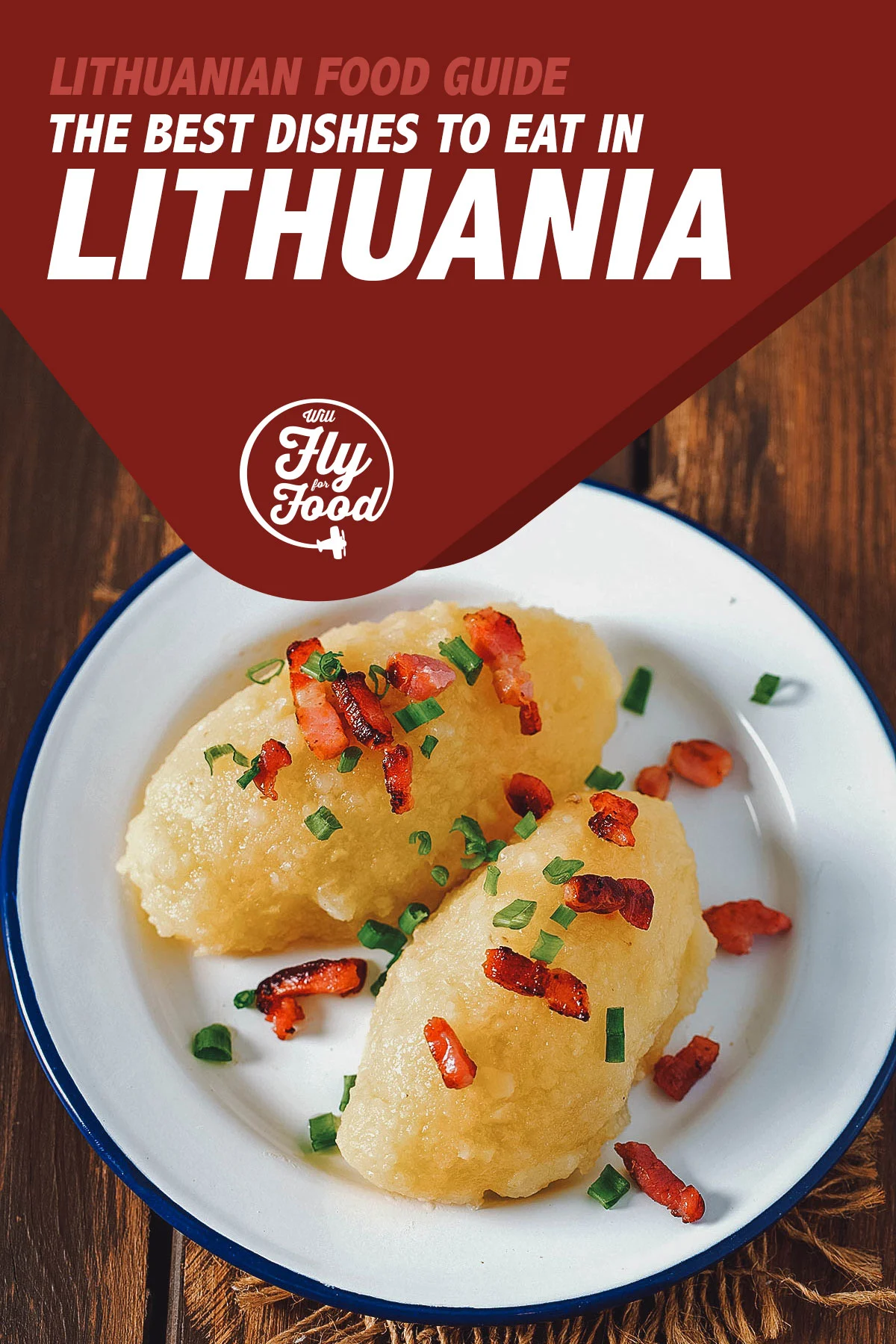
Photo by dianazh
WHAT IS TRADITIONAL LITHUANIAN FOOD?
Lithuania is a country in the Baltic region of Europe. Like its neighbors, Lithuanian food consists of agricultural products and dishes that are perfectly suited to its cold and moist northern climate.
Different types of meat, dairy products, and root vegetables like potatoes, beets, and turnips are staple ingredients in Lithuanian cuisine. Produce that could withstand the cold were essential, as are various pickling methods used to preserve food for winter.
Like Lithuania’s national dish cepelinai, traditional Lithuanian foods are often heavy and fatty. They were designed to fill you up and get you through the country’s long and cold winters.
Hearty soups are often consumed while dark rye bread has been an integral part of the Lithuanian diet for centuries. It’s eaten everyday for breakfast, lunch, and dinner and is considered the cornerstone of Lithuanian cuisine.
Like many countries, especially the ones that share borders, Lithuanian food is a product of various influences, most notably German, Russian, Byzantine, and Ottoman. One Lithuanian dish that exemplifies this is kugelis, a beloved potato casserole that was adapted from the German kugel.
THE BEST FOOD IN LITHUANIA
This Lithuanian food guide has been organized by category to make it easier to go through. Click on a link to jump to any section of the guide.
STARTERS / SIDES
1. Koldūnai
Dumplings exist in almost all if not every culture and Lithuania is no exception. Koldūnai are Lithuanian dumplings filled with various ingredients like minced meat (usually beef, mutton, or pork), curd cheese, mushrooms, herbs, and spices.
To prepare, the dumpling filling is wrapped in thin wheat flour dough and sealed in a half circle shape before being boiled in salted water. When ready, they’re served with different garnishes like sour cream, butter, bacon, and spirgučiai, which is an often used Lithuanian garnish made with fried onions and lašinlai.
Koldūnai are equally popular in the cuisines of Poland and Belarus where they’re known as kolduny or kalduny. You can think of them as the Lithuanian equivalent of pierogi or other similar dumplings like ravioli, pelmeni, or vareniki.
RECIPE: Koldūnai su kiauliena (pork dumplings)
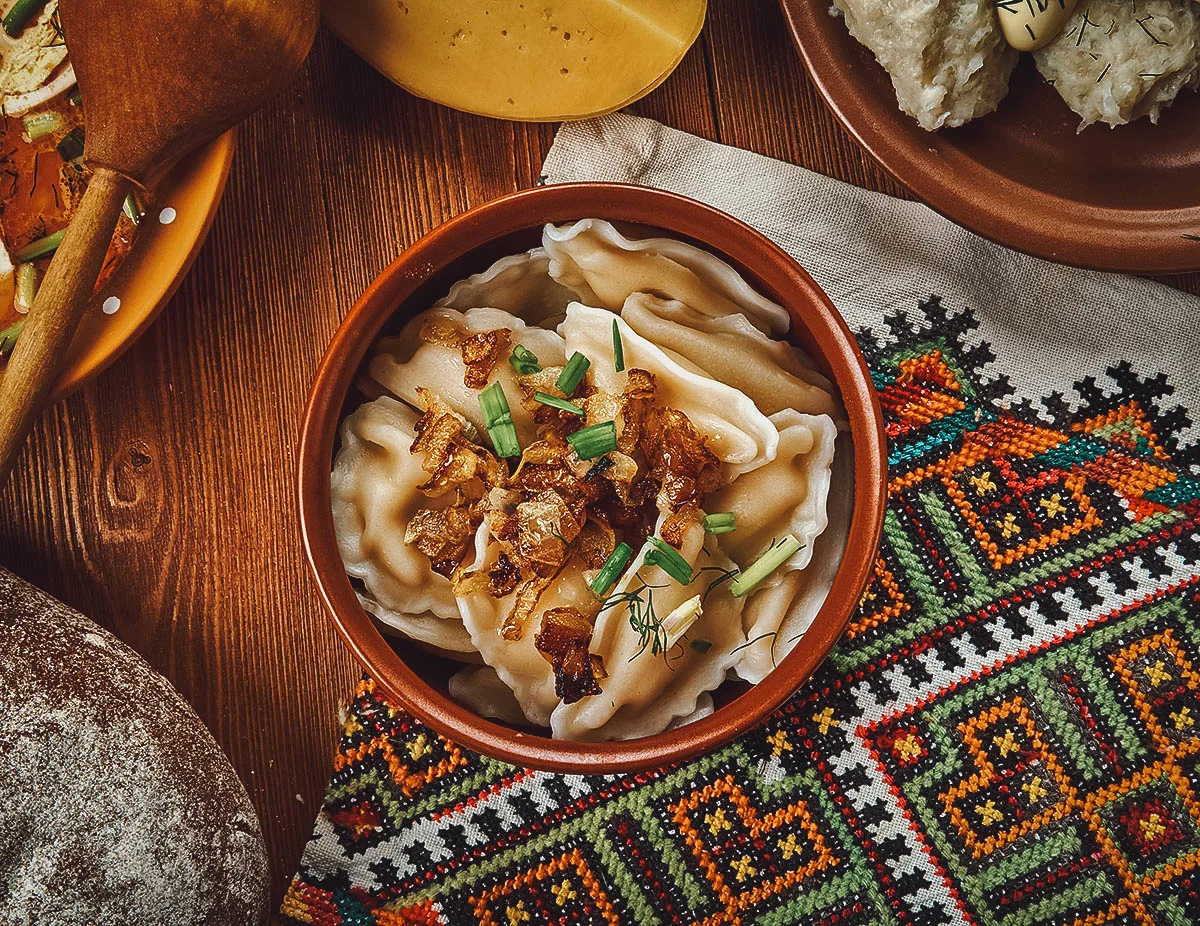
Photo by fanfon
2. Bulviniai Blynai
Bulviniai blynai are Lithuanian fried potato pancakes. A beloved comfort food in Lithuania, they’re popular in the cuisines of many European countries where they go by different names like draniki (Belarus), zemiakové placky (Slovakia), deruny (Ukraine), bramborák (Czechia), and latkes (Jewish).
Recipes vary but traditional bulviniai blynai are made with grated potatoes, diced onions, and eggs seasoned with salt, pepper, and sometimes lemon juice. Formed into patties, they’re shallow-fried till golden brown and crispy and served with sour cream, apple sauce, or jam.
If you’d like some meat with your potato pancakes, then ask for a version called kėdainių blynai. They’re a version of Lithuanian potato pancake made with ground meat.
RECIPE: Bulviniai blynai
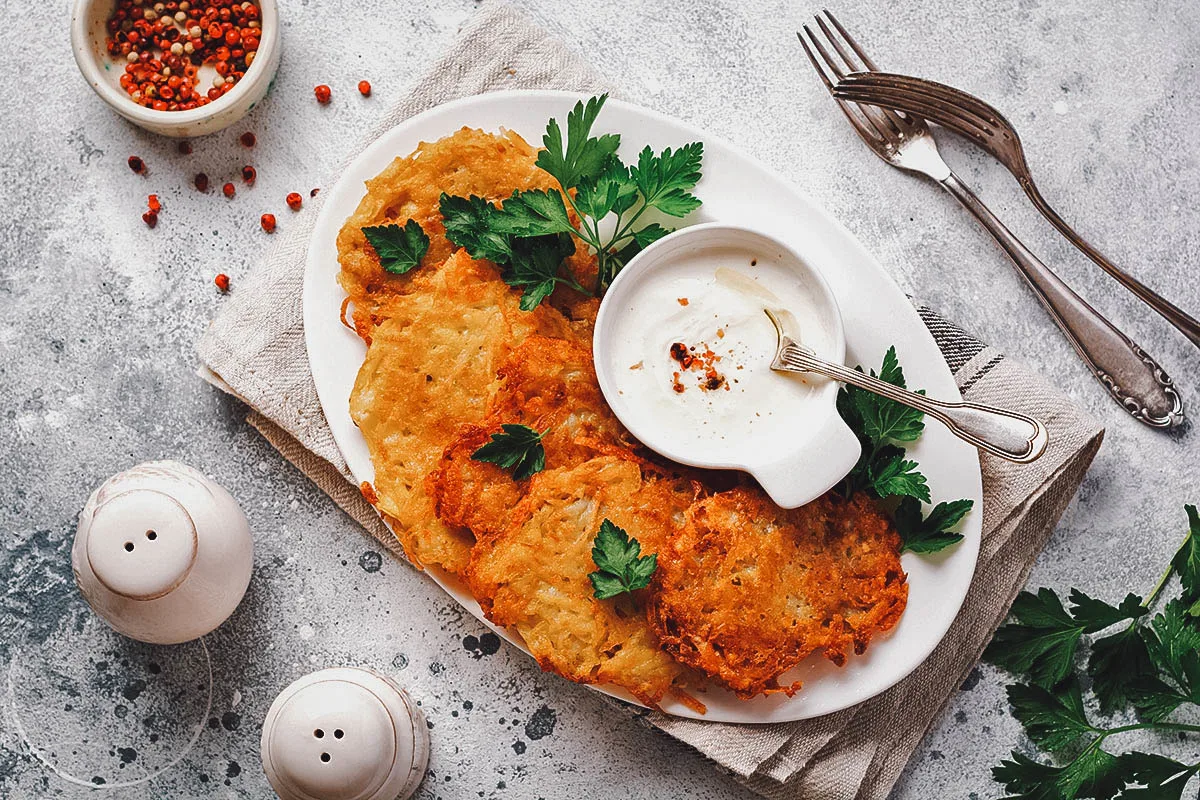
Photo by Kasia2003
3. Kugelis
Like bulviniai blynai, kugelis (or bulvių plokštainis) is a popular potato-based comfort food in Lithuania. It refers to a type of potato pudding or casserole made with oven-baked potatoes, onions, bacon, eggs, milk, and seasonings.
Kugelis can be served as a main course or side dish and is commonly eaten with sour cream, applesauce, lingonberry jam, or spirgučiai. It’s typically made for dinner but it’s often enjoyed for breakfast as well. In Lithuania, it’s common practice to consume for breakfast (and even lunch) dishes that were prepared for the previous evening’s meal.
RECIPE: Kugelis
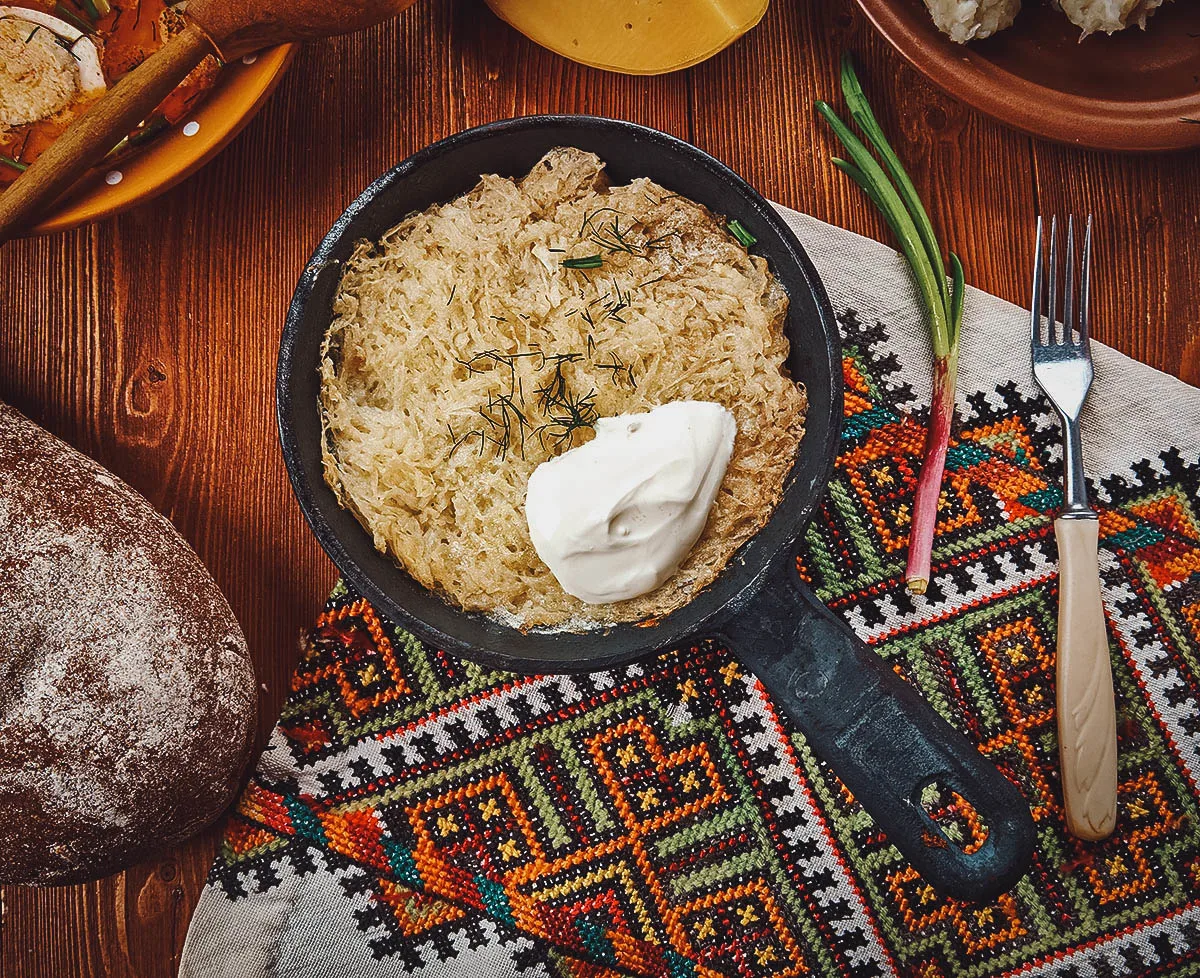
Photo by fanfon
4. Lašiniai
Lašiniai refers to non-rendered slabs of pork fatback, usually with the skin intact and little to no meat attached. It’s similar to Ukrainian and Russian salo, except the Lithuanian version is seasoned and smoked on top of being salted and cured.
Commonly eaten throughout Lithuania, lašiniai is often enjoyed as an appetizer or bar chow with rye bread and onions. It’s also the main ingredient in spirgučiai, a popular garnish used in many Lithuanian dishes.
RECIPE: Lithuanian onion and bacon buns
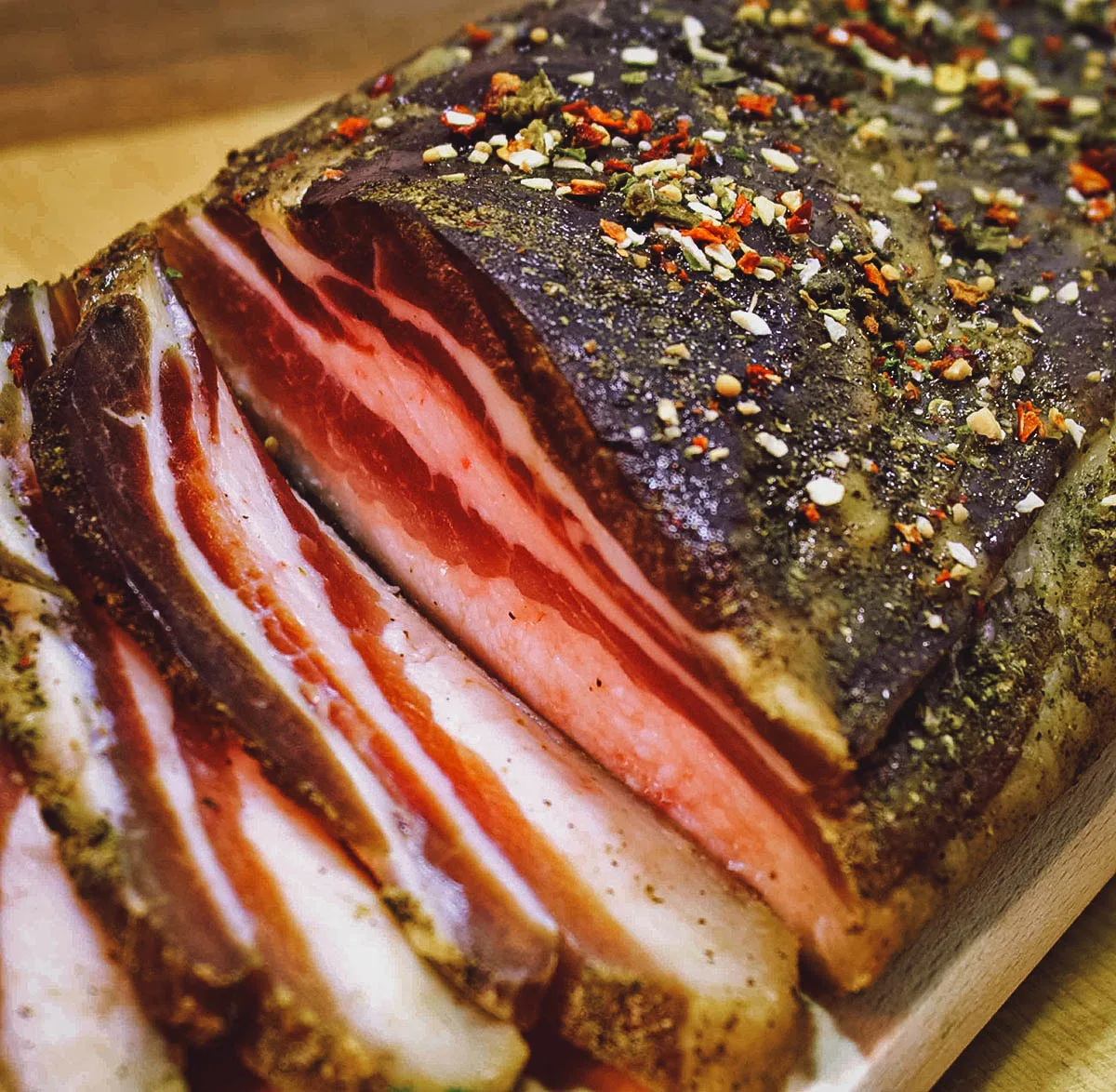
Photo by PantherMediaSeller
5. Skilandis
Skilandis (or kindziukas) refers to a pear-shaped Lithuanian sausage made from smoked pork or beef. It dates back to at least the 16th century and enjoys Protected Designation of Origin (PDO) status under European Union law. This means that it needs to be entirely produced within a specific region using traditional methods to carry the skilandis label.
To make skilandis, ground meat (usually beef and/or pork mixed with pieces of bacon) is seasoned with salt, pepper, garlic, sugar, and spices before being stuffed in a pig’s bladder or cow’s cecum. It’s closed at the top with a thick cord that’s also run along its sides to create wedges. The sausage is then cold-smoked for fifteen days before being hung up to dry in a special wooden chamber for 2-3 months.
When ready, the sausage ranges in color from crimson to dark red. It can be eaten raw or boiled, often as an appetizer with sauces or as a filling for sandwiches.
RECIPE: Skilandis
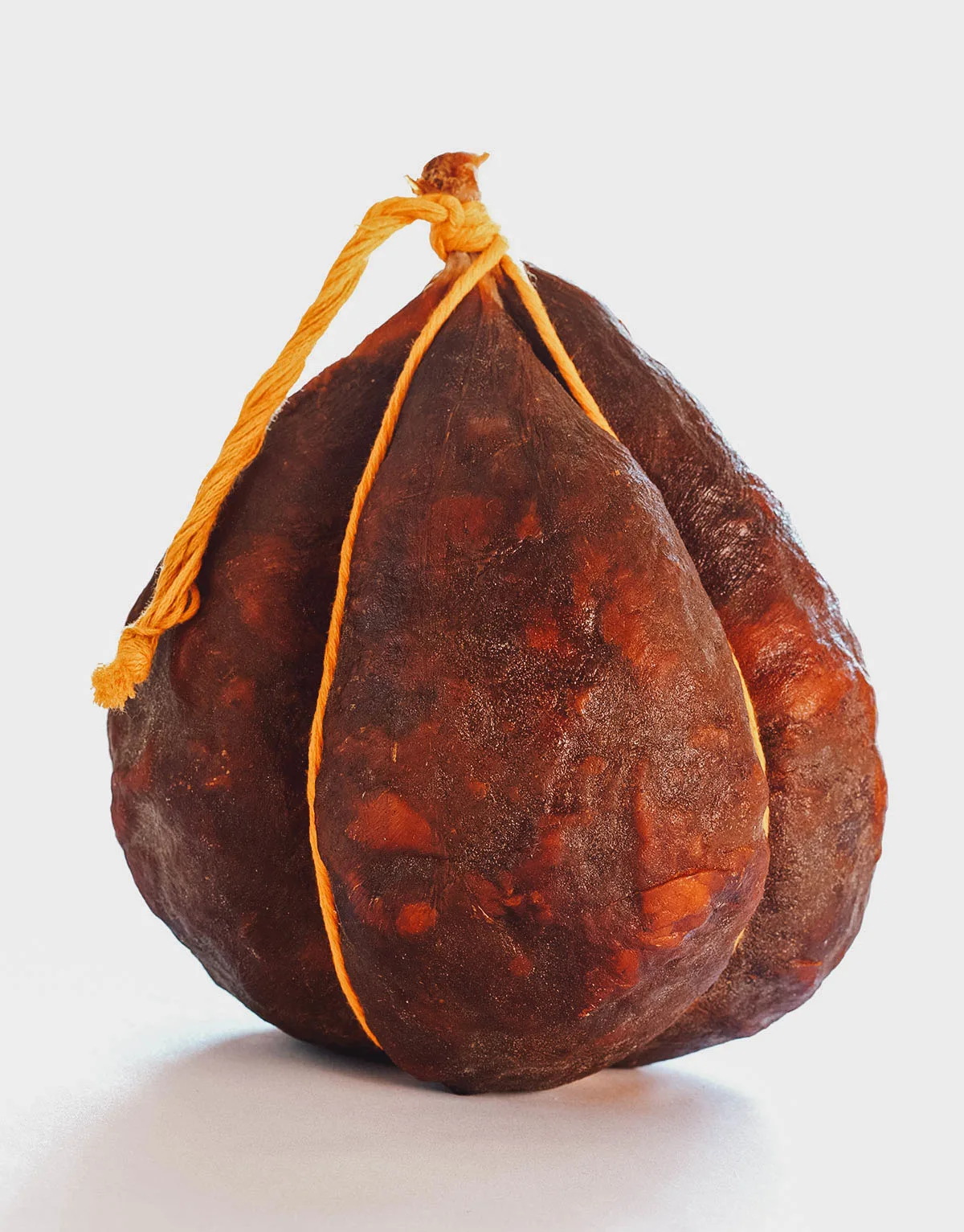
Photo by Birute
SOUPS / STEWS
6. Šaltibarščiai
Šaltibarščiai has to be one of the most photogenic Lithuanian foods. Known for its bright pink color, it’s a traditional Lithuanian soup made with pickled or cooked shredded beets blended with kefir or soured milk. It’s served chilled with finely chopped vegetables like beetroot, cucumber, radish, and green onion, along with halves of a hard-boiled egg and a good amount of dill.
Šaltibarščiai is a popular summertime soup in Lithuania. It’s a type of cold borscht soup that can be enjoyed as an appetizer or light entree, often with a side of boiled potatoes. The name šaltibarščiai literally means “cold borscht”.
RECIPE: Saltibarsciai
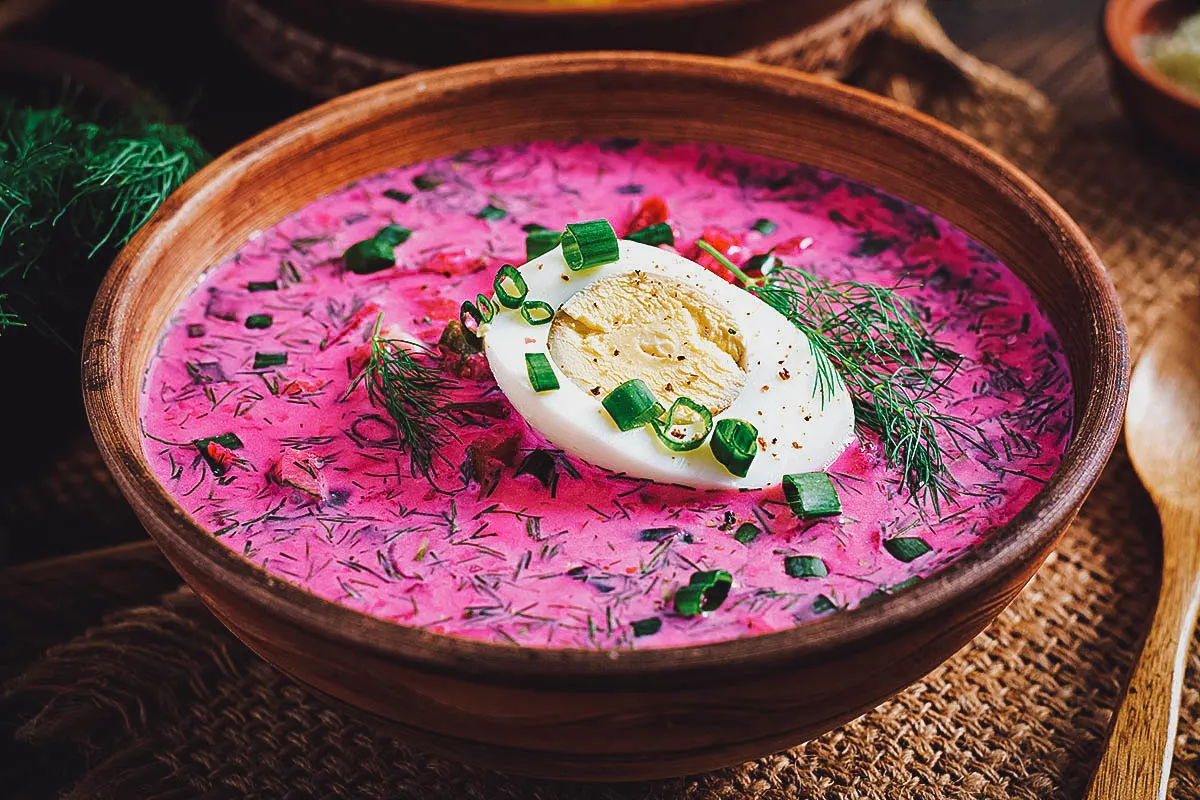
Photo by timolina
7. Bigusas
Bigusas is the Lithuanian version of bigos, a Polish stew made from different types of chopped meat, sauerkraut, and shredded fresh cabbage. Meaning “hunter’s stew” in English, bigos is originally a Polish dish that’s become a part of Belarusian (bihas or bihus) and Lithuanian cuisines as well.
Bigusas is made with various types of meat like pork, beef, veal, and poultry. They’re chopped into bite-sized chunks and stewed with a mixture of sauerkraut and shredded fresh white cabbage.
Recipes vary from cook to cook but other commonly used ingredients include onions, carrots, garlic, prunes, and tomato sauce. The stew is cooked in a large pot and flavored with a variety of spices and seasonings like cumin, nutmeg, bay leaves, salt, and pepper.
As good as it is freshly cooked, bigusas gets even better with time. Refrigerating and reheating the stew several times allows the flavors to mature and become more unified.
RECIPE: Bigusas
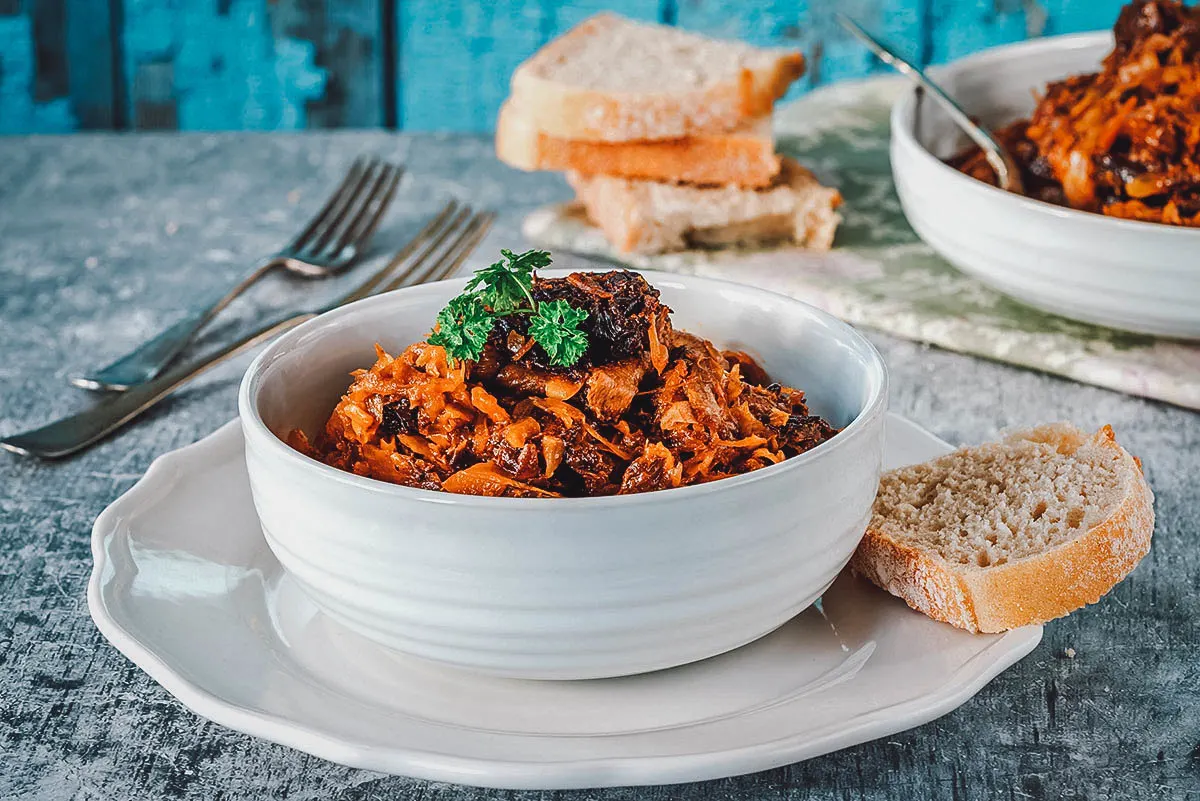
Photo by RubinowaDama
PASTRIES / BREADS
8. Kibinai
Kibinai (or kybyn) are traditional Lithuanian pastries made with ground meat, onions, sour cream, herbs, and seasonings. Associated mostly with the city of Trakai and its ethnic Karaite minority, kibinai are baked pastries similar to Cornish pasties or empanadas.
Kibinai are traditionally made with mutton or lamb but they can be made with other types of ground meat as well like beef or pork. The filling is stuffed in a kefir- or sour cream-enriched dough that’s pinch-sealed into crescent-shaped pies. The pies are then brushed with an egg wash before baking.
Popular as a snack, kibinai can be enjoyed hot or cold at ay time of the day.
RECIPE: Patys skaniausi kibinai (meat pies)
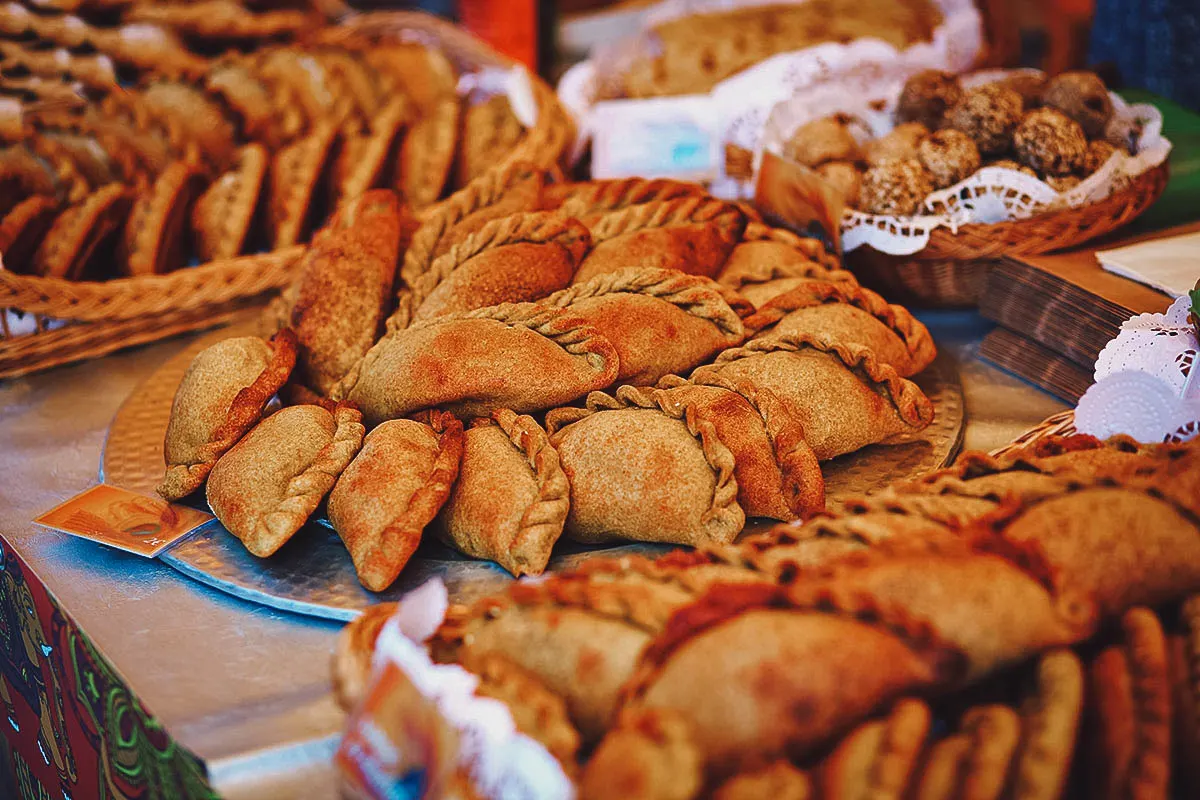
Photo by encrier
9. Baronkos
Baronkos refers to the Lithuanian version of bublik, a traditional Eastern European bread roll. Shaped like a bagel, it’s made with yeast-leavened wheat dough that’s briefly poached in water before baking.
Bubliks like baronkos are common in the cuisines of many Eastern European countries. They exist in many forms and go by different names like baranka (Russia), obarinok (Ukraine), abaranak (Belarus), and obwarzanek (Poland).
Like other forms of bublik, baronkos can be savory or more sweet. They’re often made with poppy seeds and/or sesame seeds along with other ingredients like grated cheese. They can be eaten as is, dipped in tea, or slathered with jam or sour cream.
Unlike bagels, baronokos aren’t considered breakfast food in Lithuania. They’re eaten more as a snack or as an accompaniment to tea.
RECIPE: Baronkos
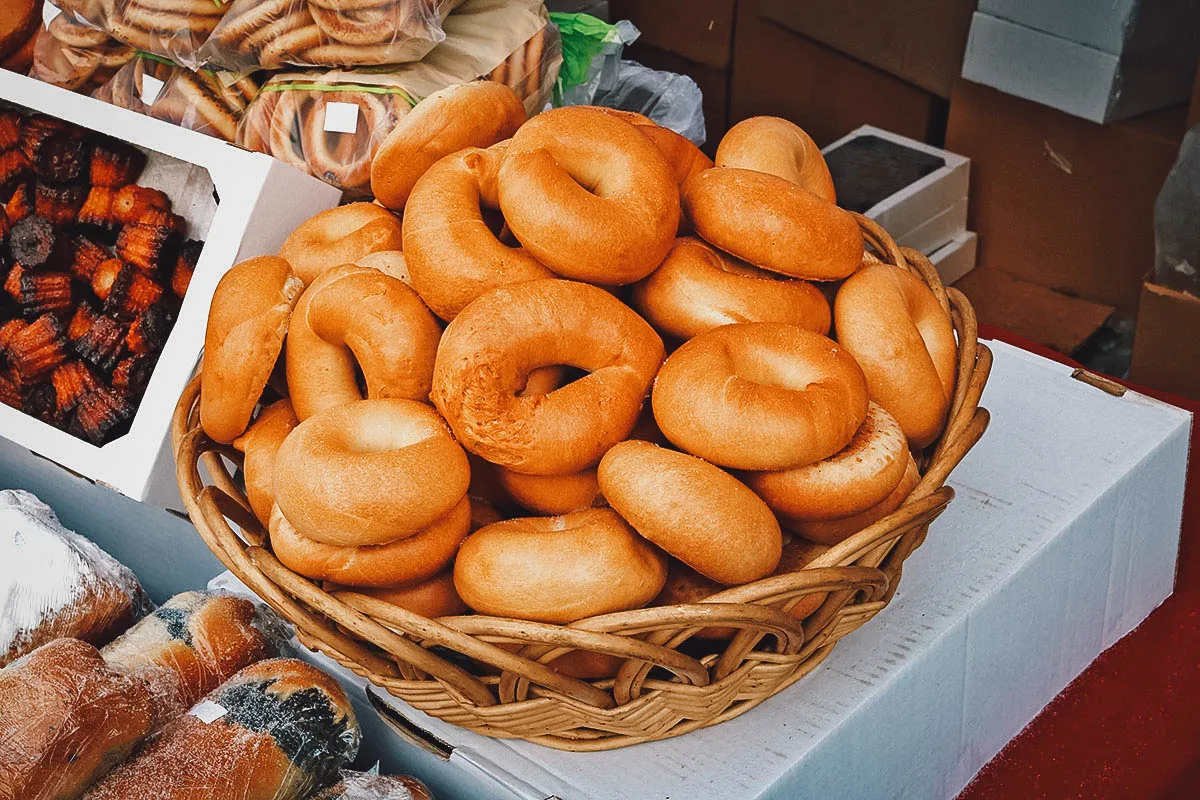
Photo by vilaxlt
Sushka is a smaller type of bublik that can also be found in Lithuania. They’re considerably smaller and drier than baronokos with a texture similar to hard crackers. Sushki taste mildly sweet and are typically eaten for dessert, usually with tea or coffee.
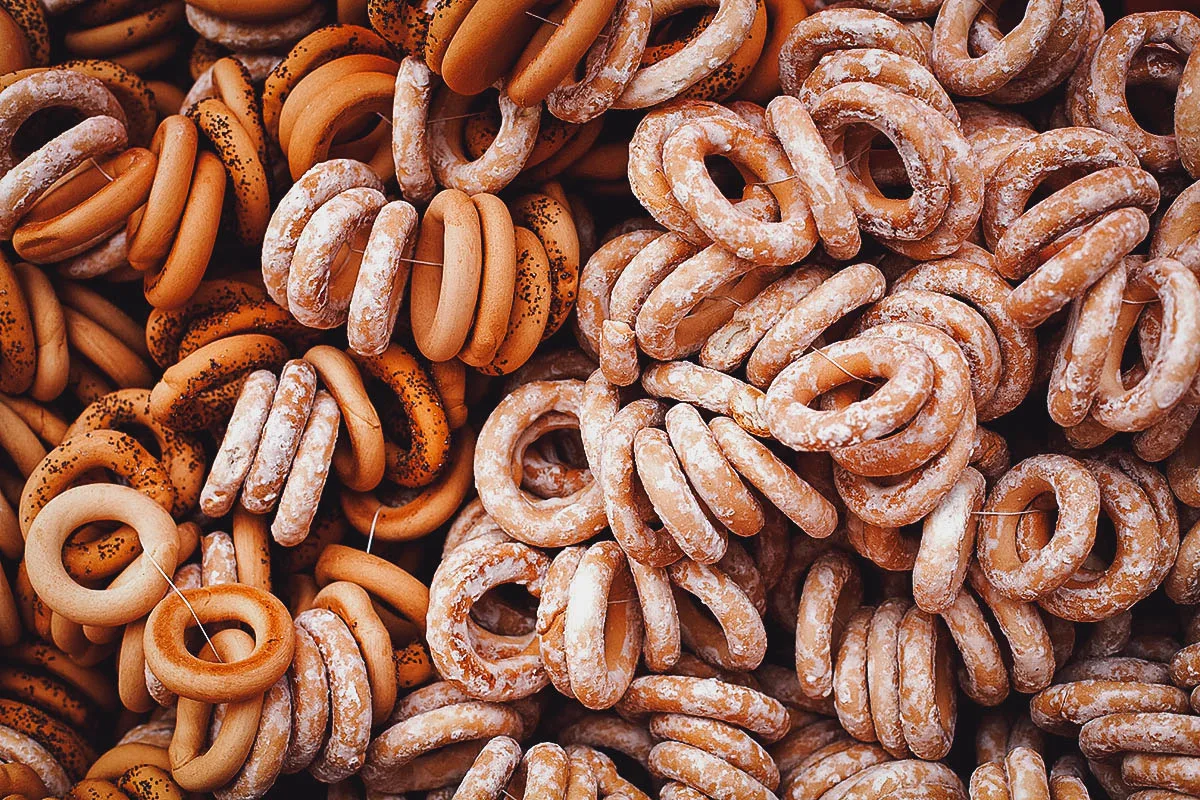
Photo by dianazh
10. Juoda Ruginė Duona
Rye bread is one of the most important foods in Lithuanian cuisine and culture. It’s an essential part of the Lithuanian diet and something that most Lithuanians can’t go a day without.
Juoda ruginė duona literally means “black rye bread” and refers to a family of traditional Lithuanian breads made with fermented dough. Recipes vary but it’s typically made with whole or ground rye flour, all purpose flour, a starter, malt, salt, sugar, honey, and water.
Rye bread is such an important part of Lithuanian cuisine that it can be found in many variations throughout the country. Some are darker, more moist, and taste relatively sour while others are lighter and sweeter.
Regardless of where you are in Lithuania, you’re sure to encounter rye bread many times during your stay, often with butter, cheese, ham, or vegetables.
RECIPE: Juoda rugine duona
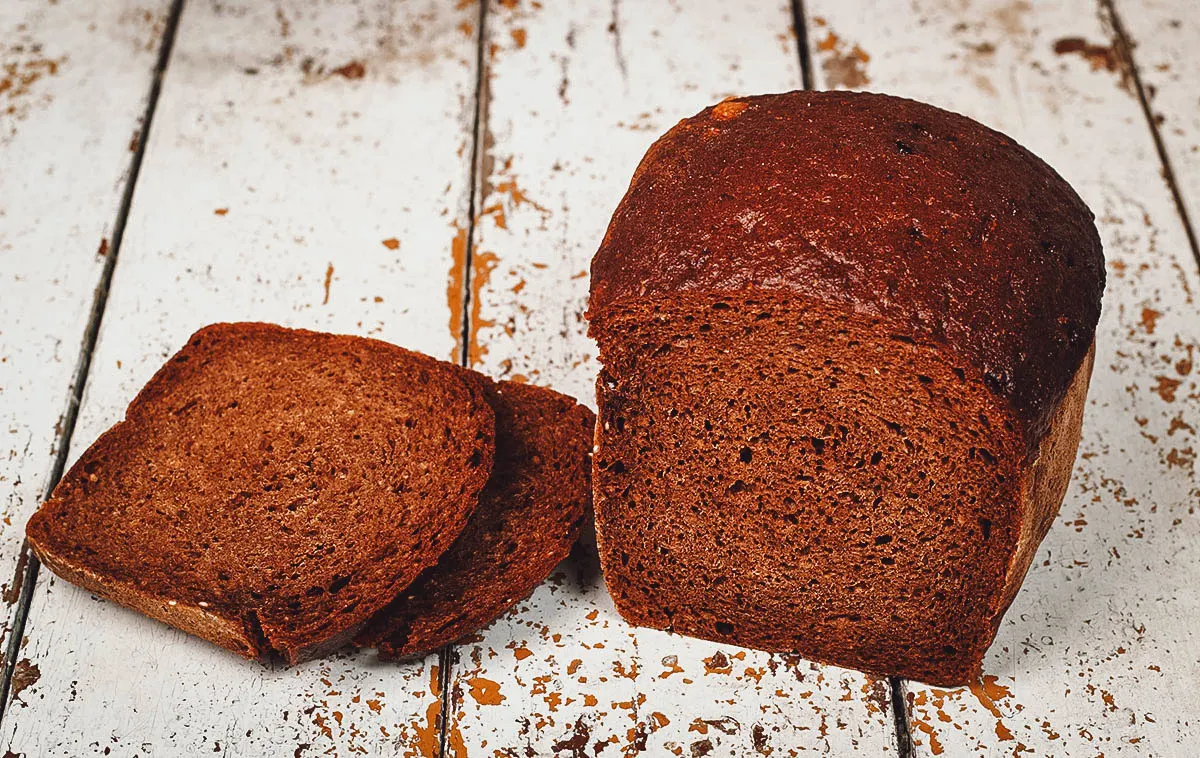
Photo by ffolas
11. Kepta Duona
If you enjoy going to bars, then you’ll probably encounter kepta duona often in Lithuania. It refers to a popular Lithuanian snack or bar chow made with fried rye bread.
To prepare, slices of rye bread are cut into narrow strips and pan-fried till crispy. They’re usually rubbed with garlic but they can also be topped with grated hard cheese or a mixture of grated cheese, garlic, and mayonnaise.
Kepta duona pairs well with beer or gira, the Lithuanian version of kvass which is a fermented beverage made from rye bread.
RECIPE: Kepta duona
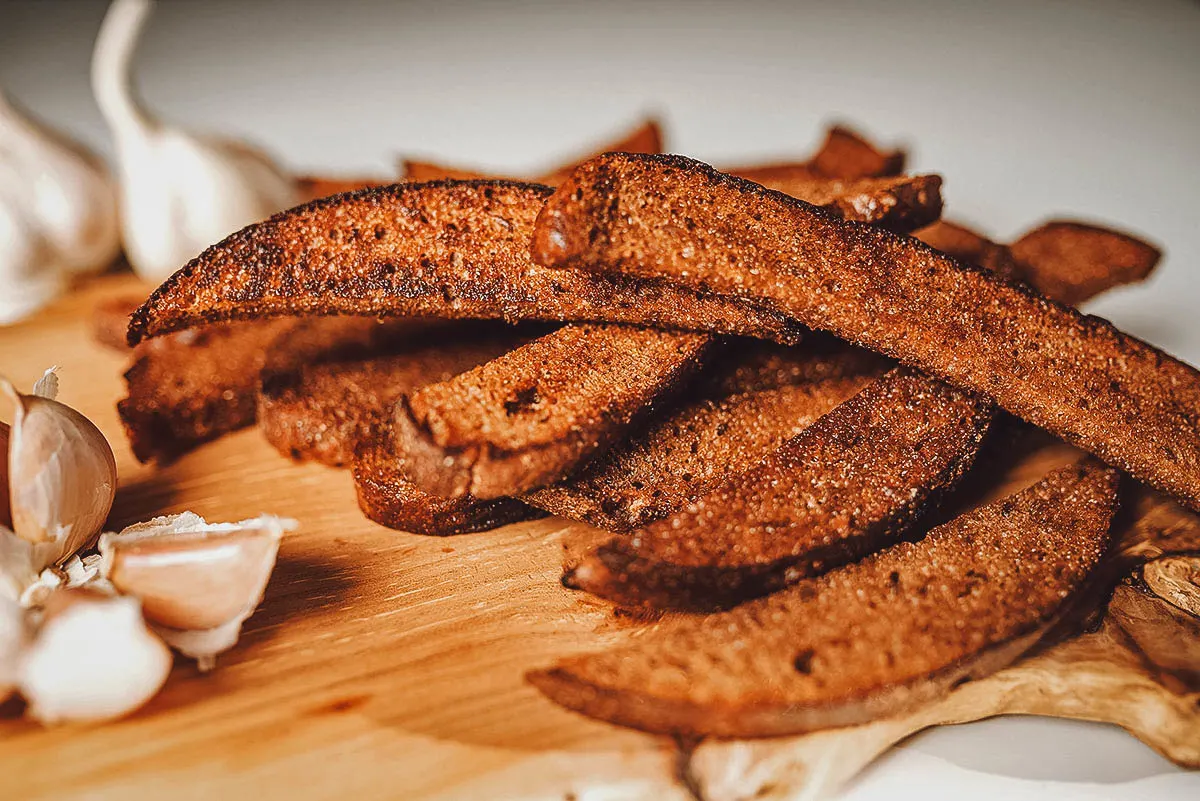
Photo by Afotoeu
MAINS
12. Cepelinai
Cepelinai (or didžkukuliai) are among the most important dishes in this Lithuanian food guide. It refers to a Lithuanian national dish consisting of dumplings made from a mixture of raw and cooked potato dough filled with ground meat (usually pork), curd cheese, or mushrooms.
A plate of cepelinai is a heavy meal so it’s usually served as an entree with bacon or spirgučiai and a generous helping of sour cream. They’re typically made in the fall during potato harvest season or to celebrate special occasions. From what I understand, these football-shaped dumplings are difficult to prepare so many Lithuanians prefer to enjoy them at restaurants rather than make them at home.
Speaking of footballs, the name cepelinai literally means “zeppelins”. Because of their shape, the dumplings were named after Graff von Zeppelin, the German general credited for inventing the airship.
RECIPE: Cepelinai
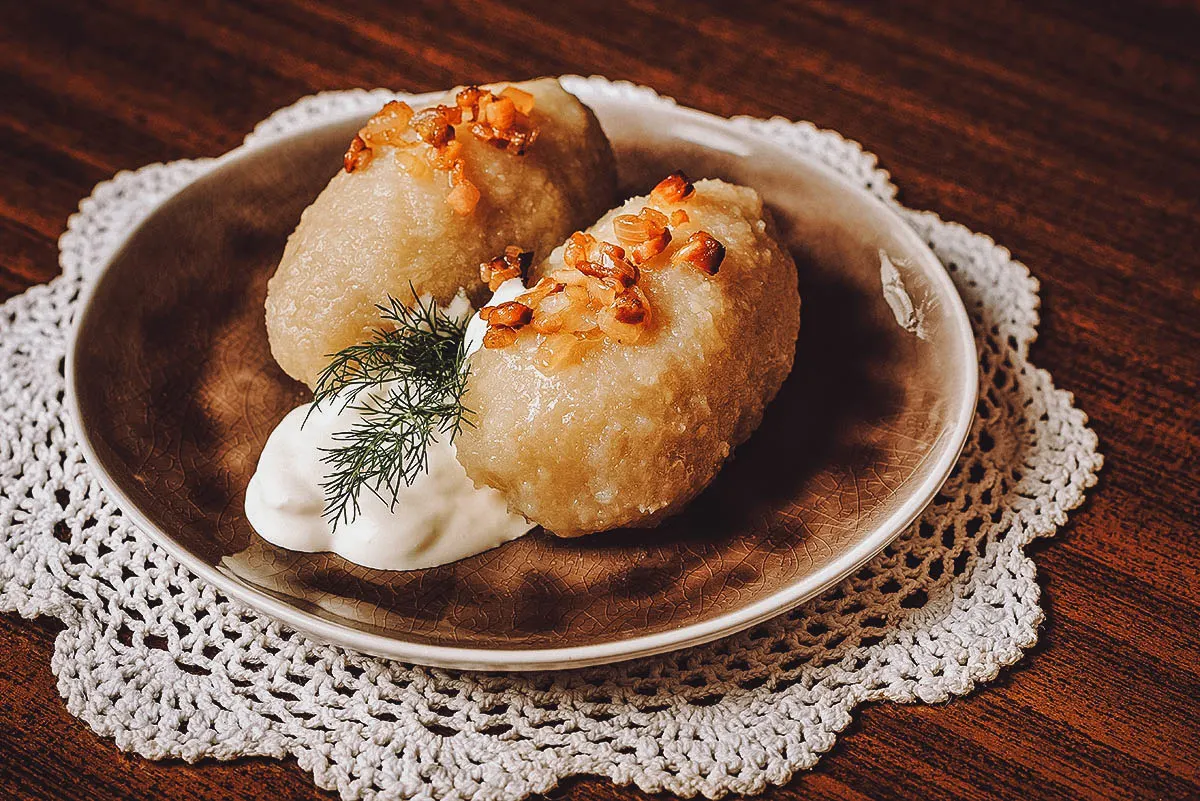
Photo by Afotoeu
13. Zrazy
Zrazy refers to a type of meat roulade popular in the cuisines of Lithuania, Poland, and Belarus. They’re made with thin slices of seasoned beef stuffed with a variety of ingredients like vegetables, potatoes, mushrooms, and eggs.
Zrazy is typically made with beef but it can be made with other types of meat as well like veal, pork, chicken, or turkey. To make, the beef is rolled over the filling and secured with thread or toothpicks. They’re then fried briefly before being stewed in a stock with celery, onions, and different spices.
When cooked, the toothpicks are removed and the zrazy is served in the sauce in which they were stewed.
RECIPE: Zrazy
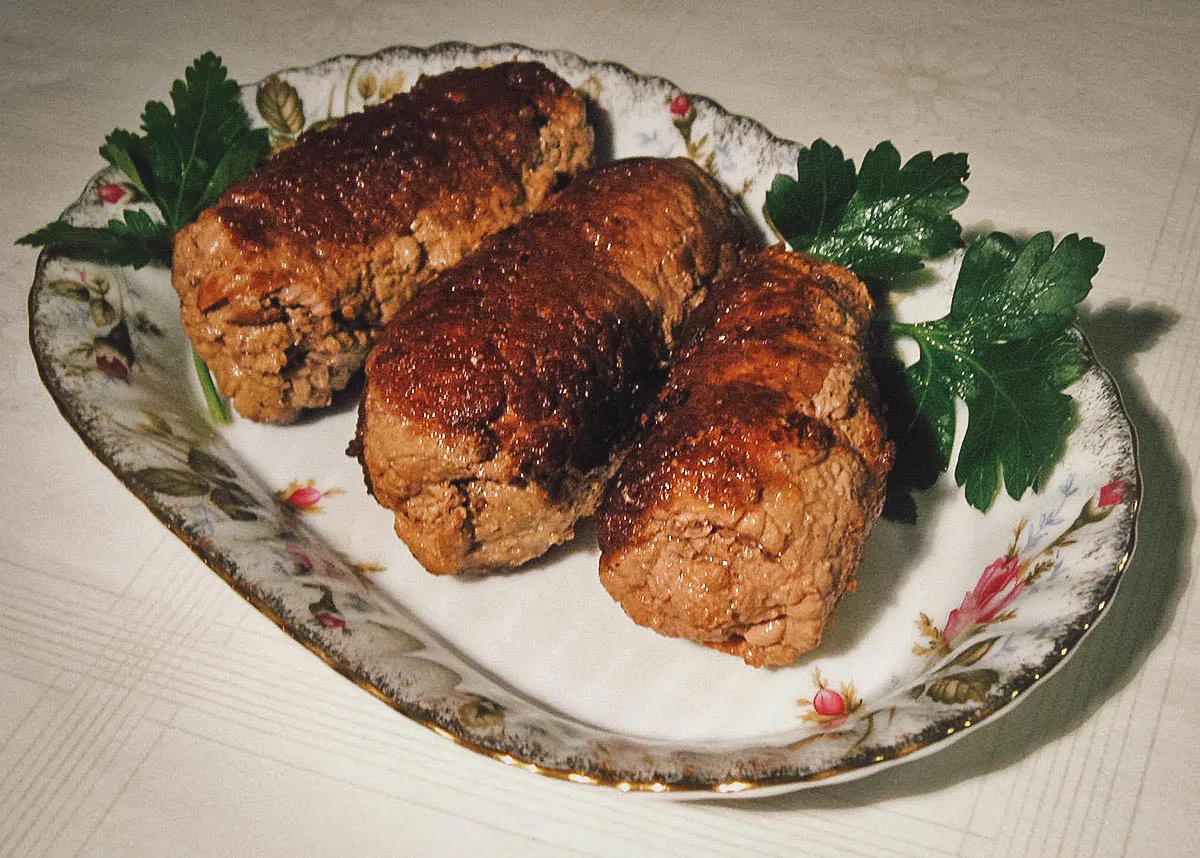
Kuruni, CC BY-SA 4.0, via Wikimedia Commons / Processed in Photoshop and Lightroom
Zrazy can also be made with potatoes instead of meat. Stuffed with a variety of fillings like meat, vegetables, or mushrooms, you can think of them as the Lithuanian version of potato croquettes.
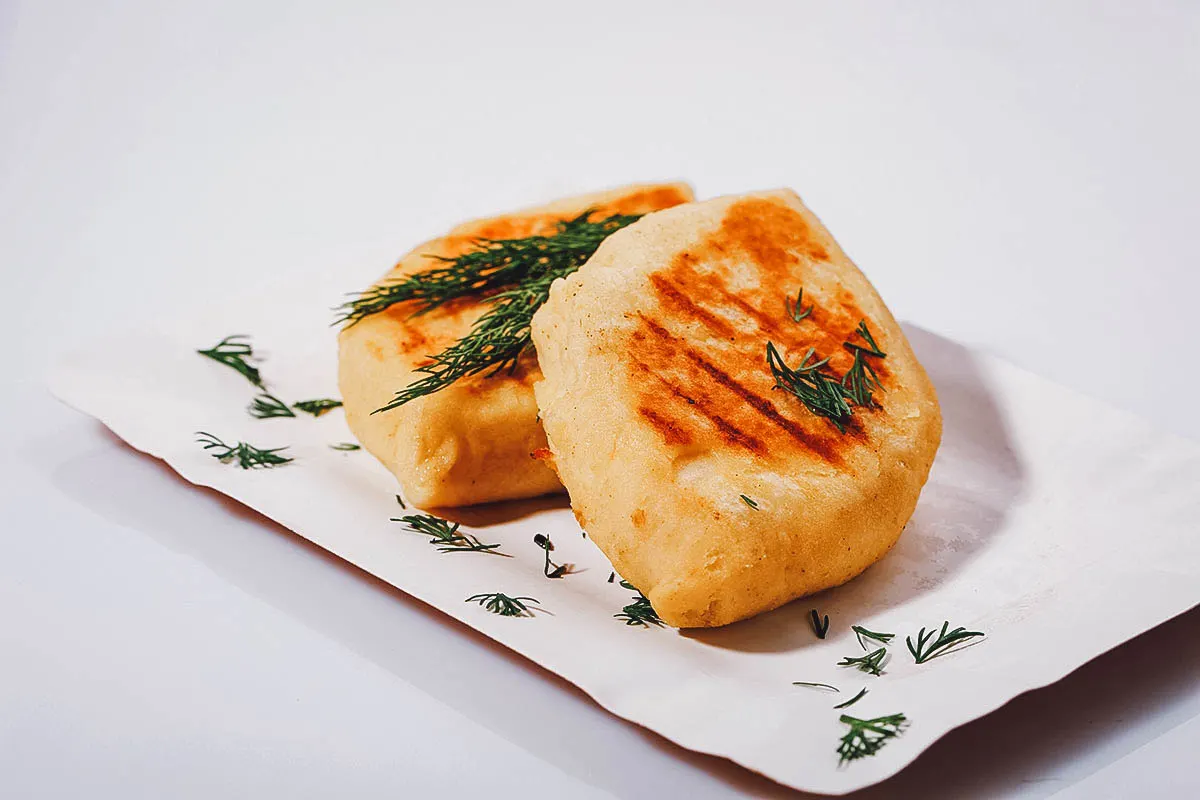
Photo by serkucher
14. Balandeliai
Balandeliai refers to Lithuanian stuffed cabbage rolls. They’re essentially the Lithuanian version of sarma, a cabbage roll dish that’s commonly eaten in Turkey, Armenia, Lebanon, Croatia, and many other countries in the Balkans, the South Caucasus, the Levant, and Central Asia.
Balandeliai is made with ground meat, usually pork, mixed with rice and onions. The filling is then rolled into boiled and softened cabbage leaves before being lightly coated in flour and quickly fried. The rolls are then stewed in a pot with water, bouillon cubes, ketchup, salt, and pepper. When cooked, they can be served with sour cream and a side of boiled potatoes.
Interestingly, the name balandeliai literally means “pigeons”. It’s unclear how it got that name but the term can also be translated to “lovebirds”. A comforting dish, perhaps balandėliai is a Lithuanian dish best shared between couples?
RECIPE: Balandeliai
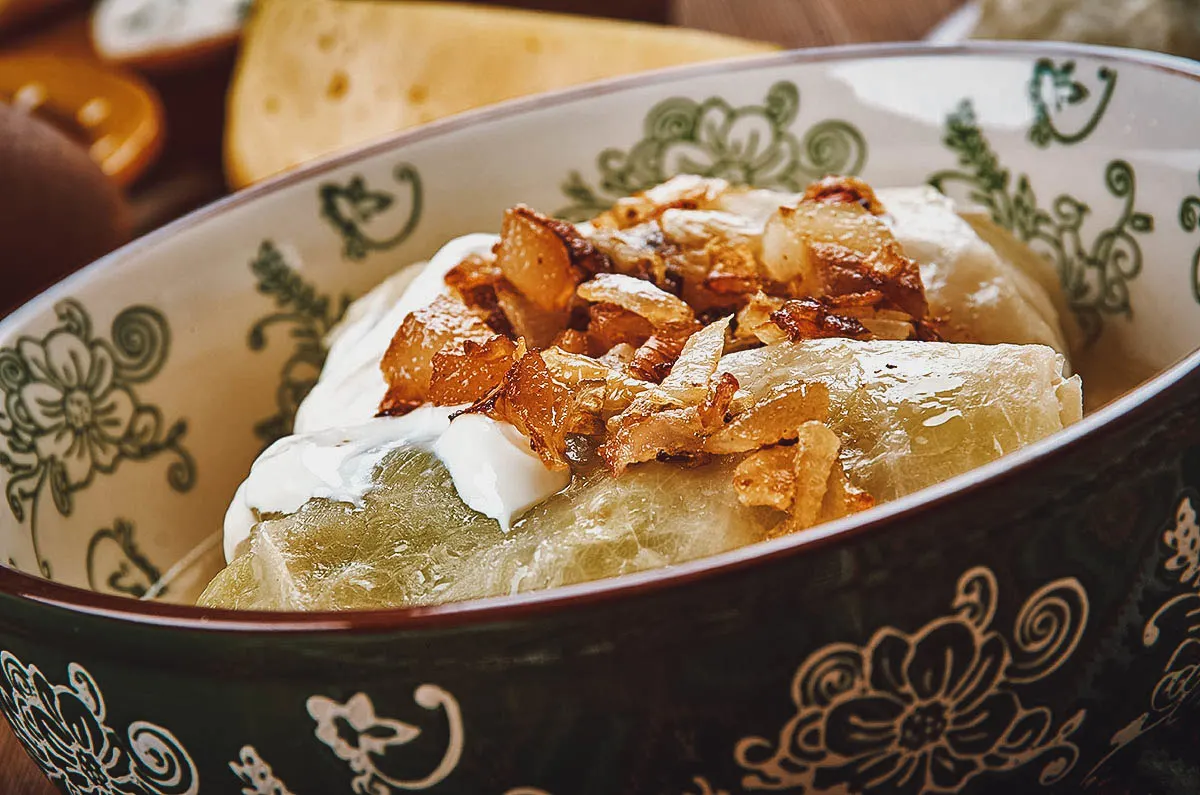
Photo by fanfon
15. Saslykai
If you enjoy barbecued meats, then you’re going to love saslykai. It’s the Lithuanian version of shashlik, a dish of skewered and grilled cubes of meat popular throughout the Caucasus and Central Asia. Similar to shish kebab, it can be made with different types of marinated meat though the Lithuanian version is typically made with pork.
To prepare, fatty cubes of pork are marinated in a mixture of onions, garlic, herbs, spices, lemon juice, and olive oil. The meat can be marinated for a few hours or overnight before being skewered and grilled over charcoal. When ready, the smokey and juicy cubes of meat are best enjoyed with rice, salad, and some ketchup.
RECIPE: Saslykai
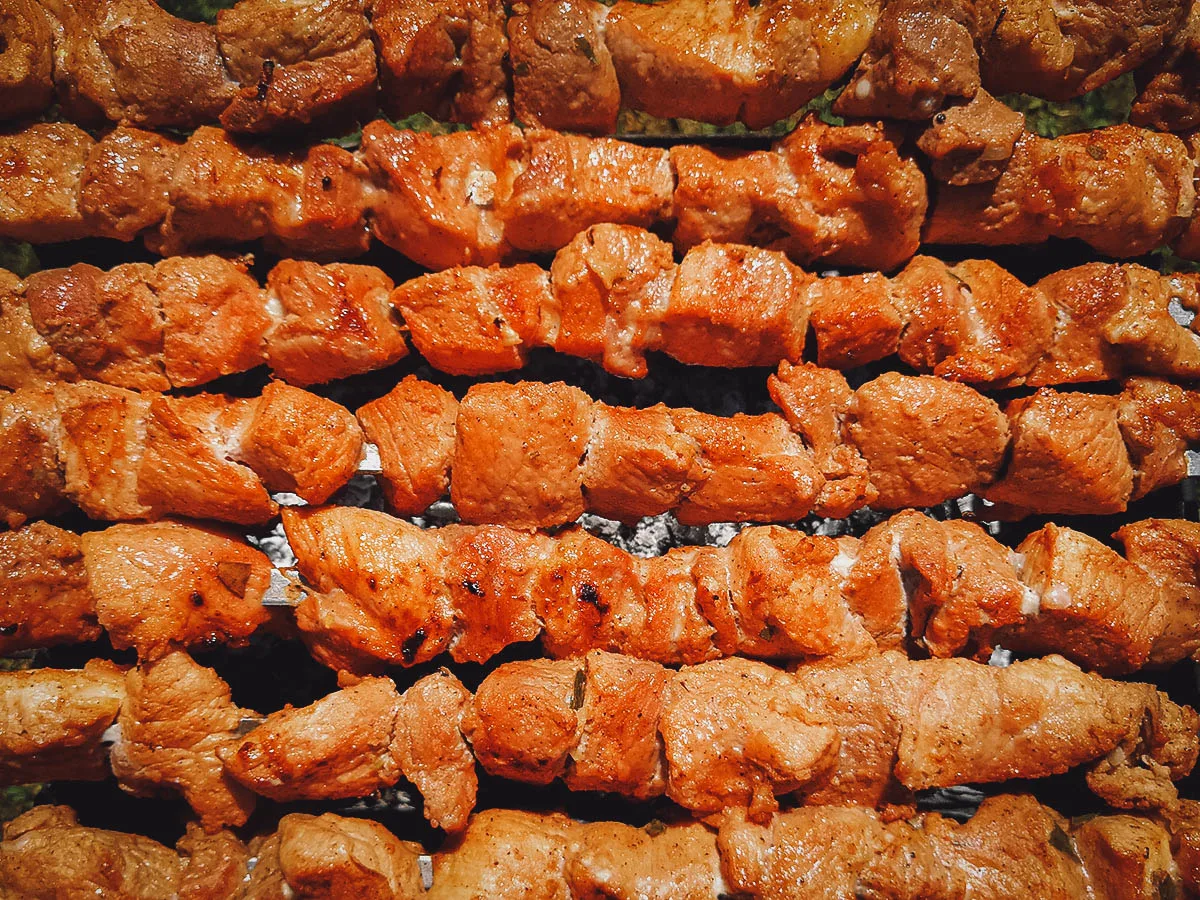
Photo by amphoto
DESSERTS / DRINKS
16. Šakotis
This tree-like cake has to be one of the world’s most unique-looking. Šakotis (or raguolis) refers to a traditional Lithuanian spit cake that’s also popular in Poland (sękacz) and Belarus (bankukha). It’s made from a thick batter consisting of butter, eggs, flour, sugar, and cream cooked on a rotating spit over an open fire or in a special oven.
The word šakotis means “branched tree” or “tree with many branches” in reference to its distinctive conical tree-like shape. It’s one of the most important traditional cakes in Lithuanian cuisine and often served on special occasions like weddings or holidays like Christmas and Easter.
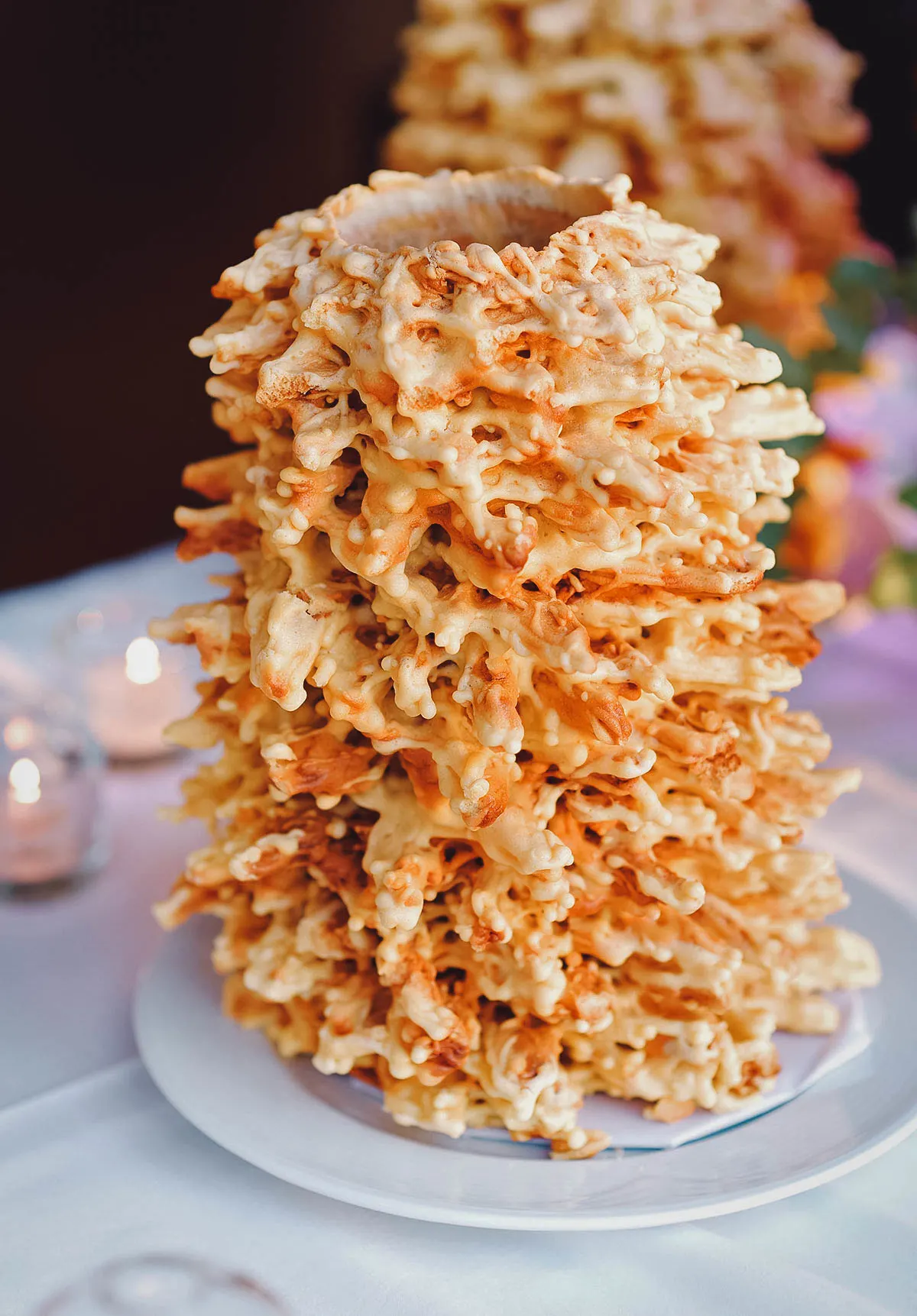
Photo by MNStudio
Making šakotis is a time- and labor-intensive process. It’s created by dripping the thick batter over the rotating spit again and again until it builds up and the cake’s characteristic drips or “branches” form. Once the cake is fully formed and lightly browned, it’s allowed to cool before being slipped off the steel rod.
To serve, the cake is sliced horizontally into rings which are then cut into smaller sections and eaten. Šakotis can sometimes be decorated with chocolate, fruits, and flower ornaments but it’s more often served plain.
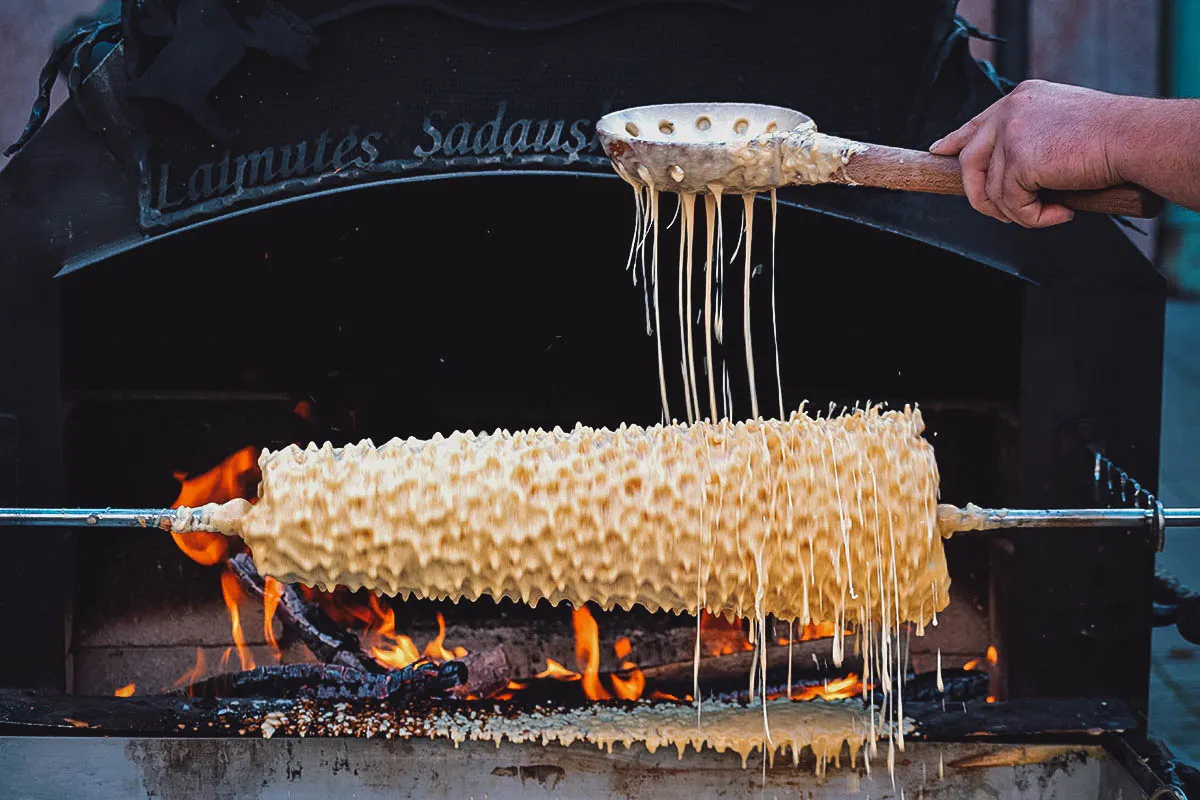
Photo by micheleursi.hotmail.com
17. Skruzdėlynas
Skruzdėlynas literally means “anthill” and refers to a traditional Lithuanian dessert made with deep-fried pieces of dough held together with honey syrup. It’s a delicious dessert that’s often prepared in many Lithuanian households.
To make skruzdėlynas, a dough made from eggs, flour, and salt is rolled out thinly and then cut into small rectangular or triangular pieces. They’re quickly fried in oil and dipped in honey syrup before being stacked into a mound and sprinkled with poppy seeds.
As tempting as skruzdėlynas is when freshly made, it’s even better the following day when the fried pieces of dough have become fully saturated with the honey syrup.
RECIPE: Skruzdelynas
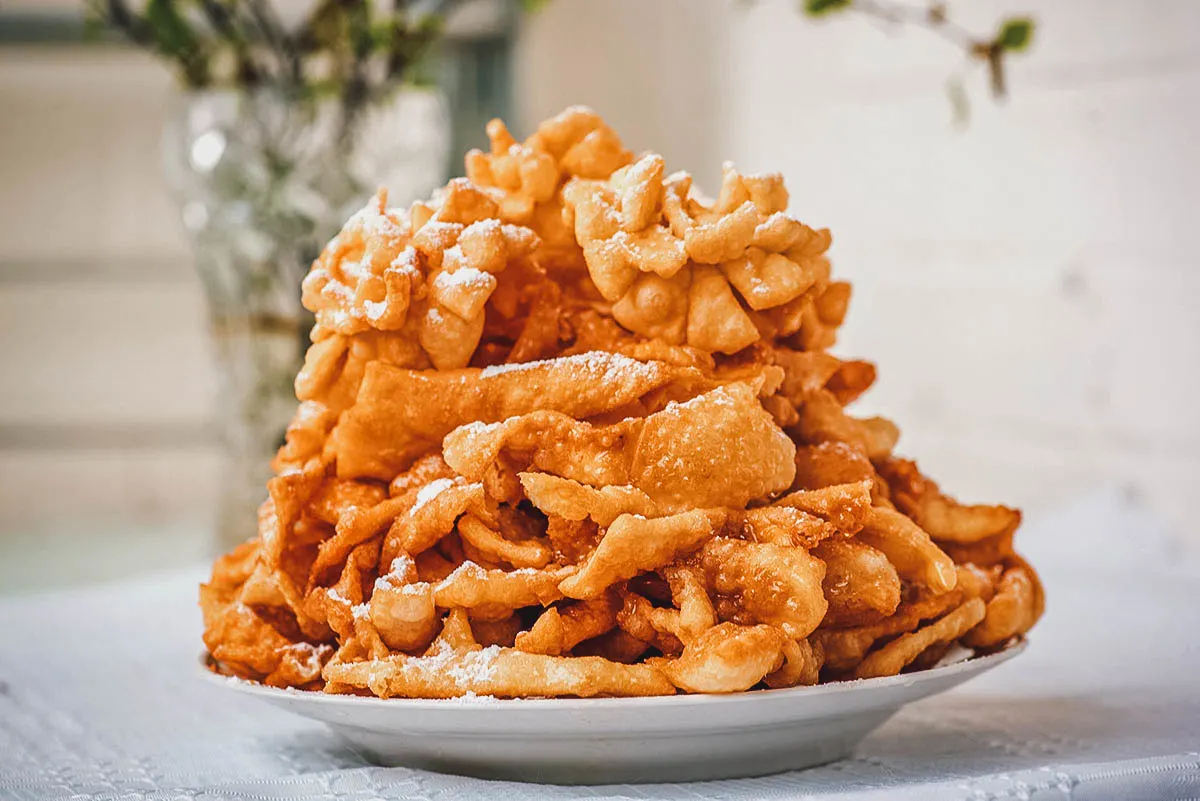
Photo by Krivis
18. Kūčiukai
In most cultures, some foods are synonymous with certain holidays. Turkey and stuffing are synonymous with American Thanksgivings while puto bumbong is often enjoyed as a Christmas dessert in the Philippines. In Lithuania, no Christmas table can ever be complete without kūčiukai.
Kūčiukai (or šližikai, prėskutė) are small, slightly sweet Lithuanian Christmas biscuits made from leavened dough and poppy seeds. Also known as Christmas cakes, they’re usually the main treat served on Kūčios, the traditional Christmas Eve dinner in Lithuania.
Kūčiukai vary in sweetness and can be eaten as is or soaked in poppy seed milk. They can also be enjoyed with cow’s milk but old Lithuanian traditions dictated that no animal products should be consumed on Christmas Eve so poppy seed milk was traditionally paired with kūčiukai instead of dairy.
It’s interesting to learn that kūčiukai has a symbolic meaning that’s carried over since pagan times. It’s regarded as a ceremonial bread and symbol of love offered to spirits. Lithuanian families would often set a portion of kūčiukai out overnight for the spirits of their deceased relatives to enjoy.
RECIPE: Kuciukai
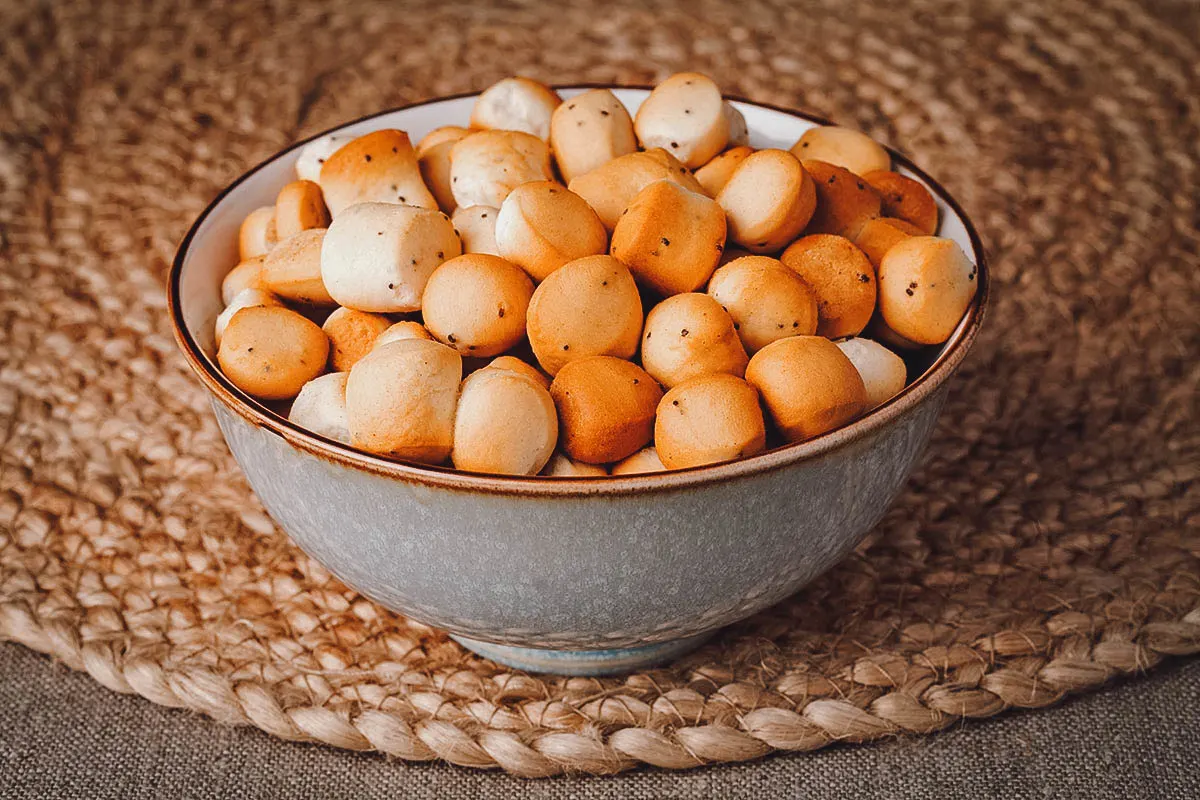
Photo by fotomem
19. Grybai
Grybai are Lithuanian mushroom cookies. You won’t go on a trip from eating them but you may get a nice sugar high after downing a few of these adorable mushroom-shaped gingerbread cookies. Like kūčiukai, they’re a popular Christmas tradition in Lithuania.
Recipes vary but grybai are typically made with eggs, sugar, flour, cinnamon, ginger, cardamom, cloves, and nutmeg. They’re often covered in icing and sprinkled with poppy seeds or candy sprinkles.
RECIPE: Grybai
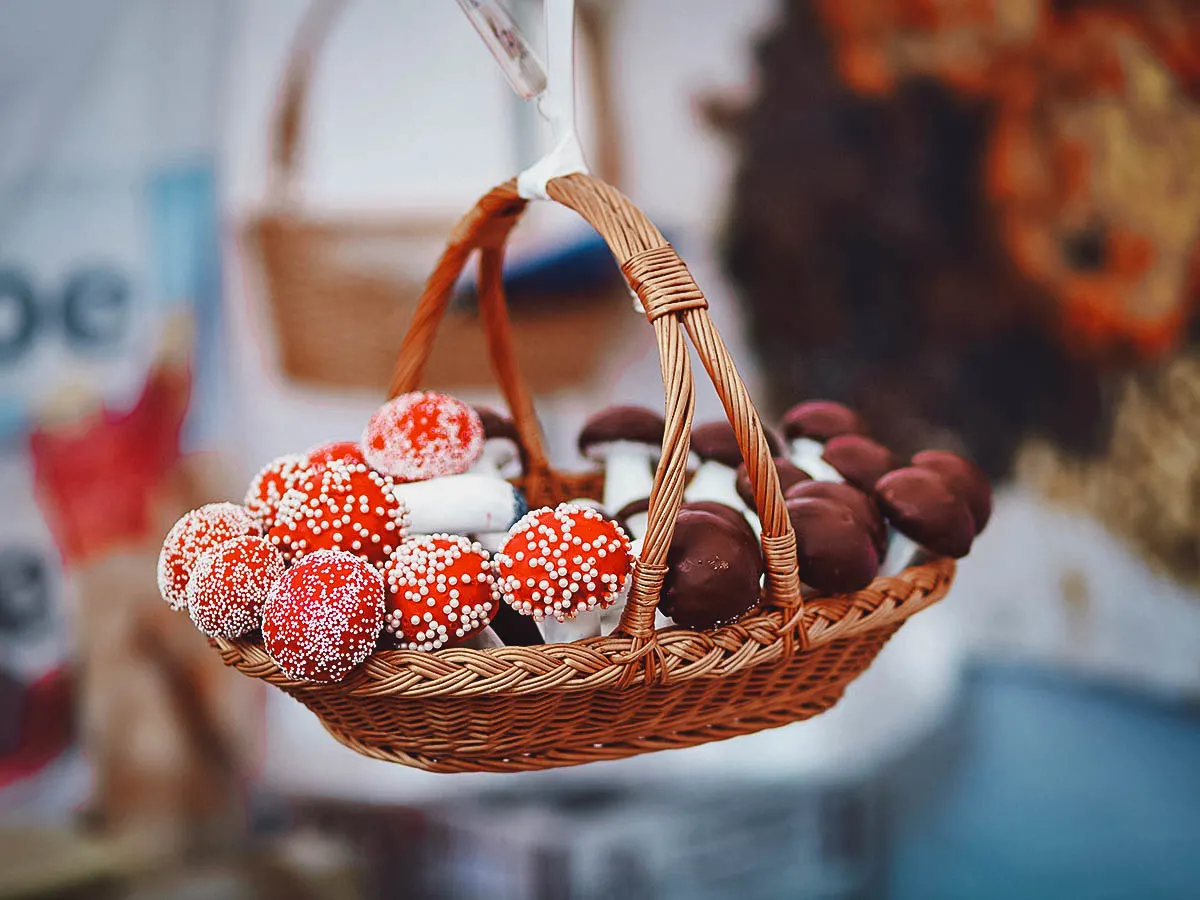
Photo by encrier
20. Midus
We love a good drink as much as food so we couldn’t wrap up this Lithuanian guide without including at least one alcoholic beverage. And there’s no better drink to highlight than midus, an ancient Lithuanian mead made with honey and berry juice infused with a multitude of ingredients like juniper berries, acorns, carnation blossoms, and poplar buds.
Midus typically contains around 8-17% alcohol but it can be made much stronger, up to 75% alcohol. It’s usually served in small glasses and goes well with spicy meat dishes.
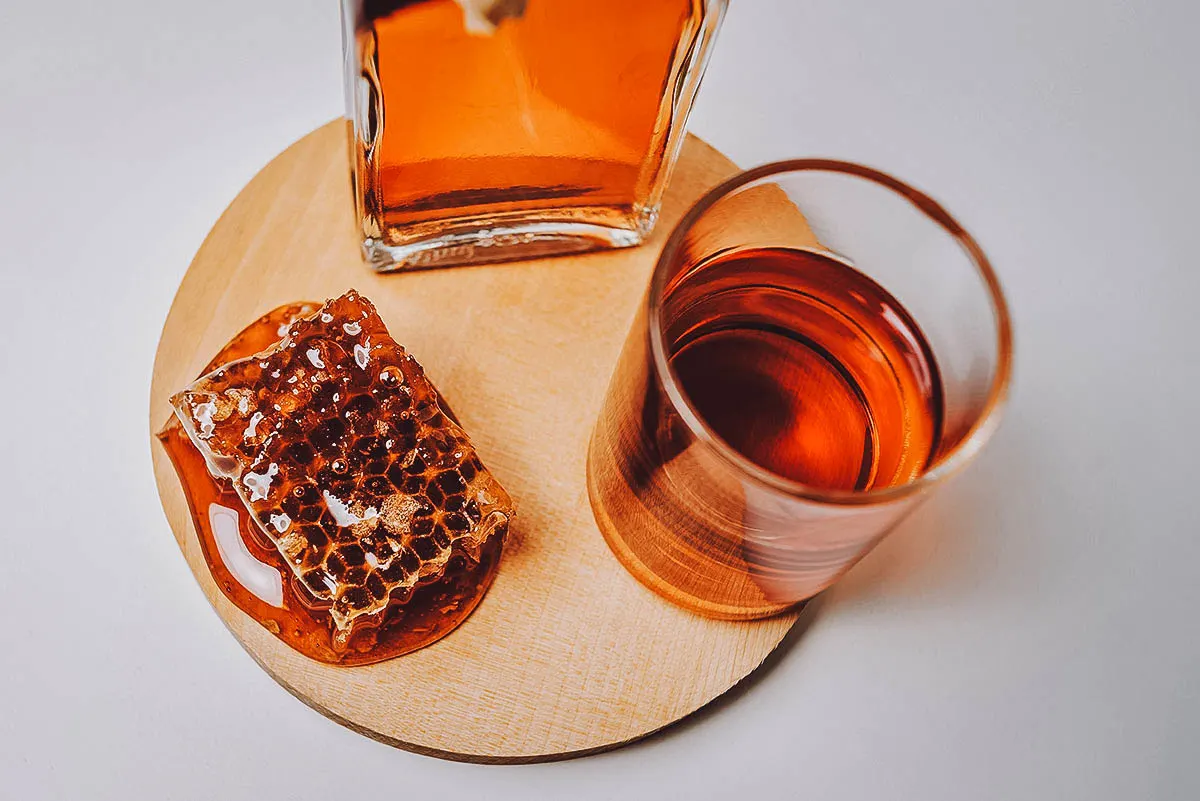
Photo by Afotoeu
LITHUANIAN FOOD TOURS
Finding all these dishes on your own is easy, but if you’d like to get a better understanding of Lithuanian food, then you may want to go on a food tour. Simply put, no one knows Lithuanian food more than a local, so what better way to experience traditional Lithuanian cuisine than by going on a guided food tour?
Not only can a local take you to the city’s best markets and restaurants, but they’ll be able to explain all the dishes to you in more detail. Check out Get Your Guide for a list of Lithuanian food and drinking tours in Vilnius and other destinations in the country.
FINAL THOUGHTS ON LITHUANIAN FOOD
Like many of its Baltic neighbors, traditional Lithuanian food is simple and hearty. It’s comforting food that’s meant to fill you up and get you through the winter.
Dishes like cepelinai and šaltibarščiai may not be as well-known internationally but to many Lithuanians, they’re the best-tasting dishes in the world.
The fact that rye bread is viewed as holy and eating is a revered event says a lot about how Lithuanians perceive their food. For many people, it’s a source of national pride, one that’s meant to be respected, appreciated, shared, and celebrated.
Disclosure
Some of the links in this Lithuanian food guide are affiliate links. If you make a booking, then we’ll earn a small commission at no additional cost to you. As always, we only recommend products and services that we use ourselves and firmly believe in. We really appreciate your support as it helps us make more of these free travel and food guides. Thank you!
Cover photo by myviewpoint. Stock images via Depositphotos.

